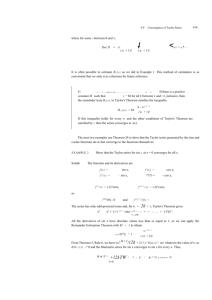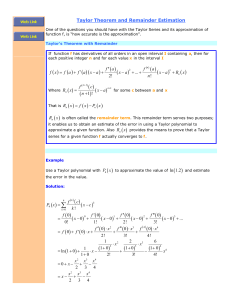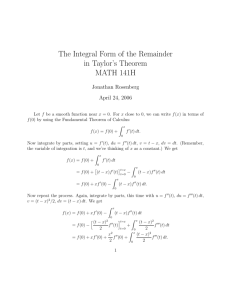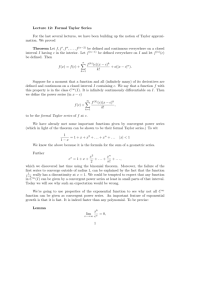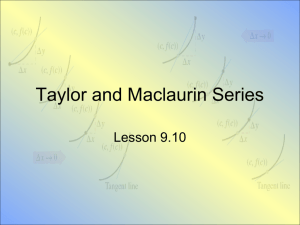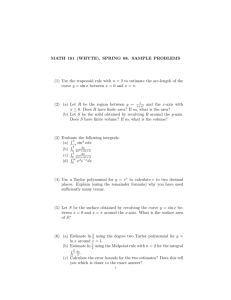Lesson 9.3
advertisement
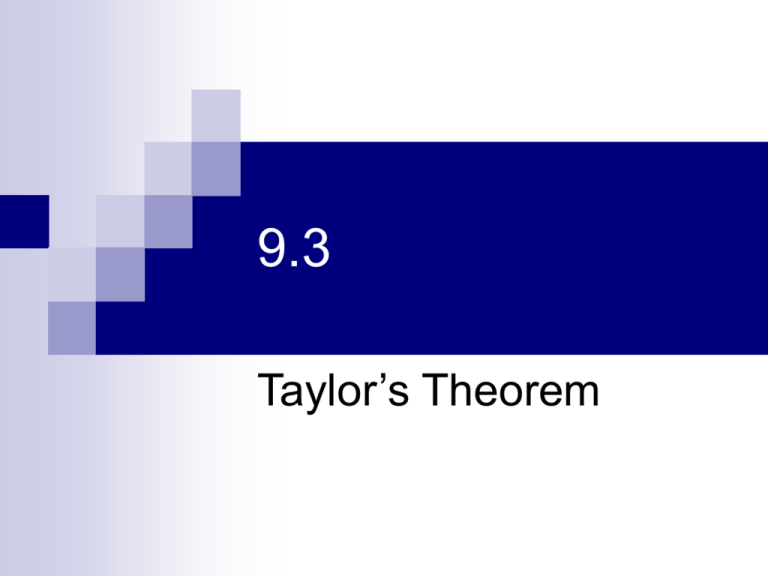
9.3 Taylor’s Theorem Quick Review Find the smallest number M that bounds f from above on the interval I (that is, find the smallest M such that f ( x) M for all x in I ). 1. f ( x) 2 cos(3 x), I -2 , 2 2. f ( x) x 3 I 1, 2 2 3. f ( x) 2 x I -3, 0 x 4. f ( x) I -2, 2 x 1 2 2 7 1 1 2 Quick Review Tell whether the function has derivatives of all orders at the of derivatives has function the whether Tell given values of a. x , a0 5. x 1 6. x 4 , a 2 2 7. sin x cos x, a 8. e , a 0 -x 3 2 9. x , a 0 Yes No Yes Yes No all orde What you’ll learn about Taylor Polynomials The Remainder Remainder Estimation Theorem Euler’s Formula Essential Questions How do we determine the error in the approximation of a function represented by a power series by its Taylor polynomials? Example Approximating a Function to Specifications 1. Find a Taylor polynomial that will serve as an adequate substitute for sin x on the interval [– , ]. Choose Pn(x) so that |Pn(x) – sin x| < 0.0001 for every x in the interval [– , ]. We need to make |Pn() – sin | < 0.0001, because then Pn then will be adequate throughout the interval Pn sin 0.0001 Pn 0.0001 3 3! 5 5! 7 7! Evaluate partial sums at x = , adding one term at a time. 9 11 13 9 ! 11! 13 ! 2.114256749 10 5 Taylor’s Theorem with Remainder Let f has a derivative of all orders in an open interval I containing a, then for each positive integer n and for each x in I f a f n a 2 x a x a n Rn x , f x f a f a x a 2! n! f n1 c n 1 x a for some c between a and x. where Rn x n 1! Example Proving Convergence of a Maclaurin Series 2 k 1 x k 2. Prove that the series 1 converges to sin x for all real x. 2k 1! k 0 n 1 Consider Rn(x) as n → ∞. By Taylor’s Theorem, Rn x c x a n1 n 1! f where f (n+1)(c) is the (n + 1)st derivative of sin x evaluated at some c between x and 0. Since, 1 f n1 c 1 n 1 n 1 x 1 f c n 1 n 1 x x 0 Rn x n 1! n 1! n 1! As n → ∞, the factorial growth is larger in the bottom than the exp. growth in the top. Therefore, as n x n1 n 1! 0 for all x. This means that Rn(x) → 0 for all x. Remainder Estimation Theorem If there are positive constants M and r such that f n 1 t Mr n 1 for all t between a and x, then the remainder Rn(x) in Taylor’s Theorem satisfies the inequality Rn x M r n 1 xa n 1! n 1 . If these conditions hold for every n and all the other conditions of Taylor’s Theorem are satisfied by f , then the series converges to f (x). Example Proving Convergence 3. Use the Remainder Estimation Theorem to prove the following for k all real x. x x e k 0 k! We have already shown this to be the Taylor series generated by e x at x = 0. We must verify Rn(x) → 0 for all x. To do this we must find M and r such that f n1 t et is bounded by Mr n1 for t between 0 and arbitrary x. Let M be the maximum value for e t and let r = 0. If the interval is [0, x ], let M = e x . If the interval is [x, 0 ], let M = e 0 = 1. In either case, e x < M throughout the interval, and the Remainder Estimation Theorem guarantees convergence. Euler’s Formula e cos x i sin x ix Quick Quiz Sections 9.1-9.3 1. Which of the following is the sum of the series n 0 (A) e e - -e (C) -e (B) 2 2 e (D) e - (E) The series diverges 2 e n 2n ? Quick Quiz Sections 9.1-9.3 1. Which of the following is the sum of the series n 0 (A) e e - -e (C) -e (B) 2 2 e (D) e - (E) The series diverges 2 e n 2n ? Quick Quiz Sections 9.1-9.3 2. Assume that f has derivatives of all orders for all real numbers x, f (0) 2, f '(0) -1, f ''(0) 6, and f '''(0) 12. Which of the following is the third order Taylor polynomial for f at x 0? (A) 2 x 3x 2 x (B) 2 x 6 x 12 x 1 (C) 2 x 3 x 2 x 2 (D) 2 x 3 x 2 x (E) 2 x 6 x 2 3 2 3 2 3 2 2 3 Quick Quiz Sections 9.1-9.3 2. Assume that f has derivatives of all orders for all real numbers x, f (0) 2, f '(0) -1, f ''(0) 6, and f '''(0) 12. Which of the following is the third order Taylor polynomial for f at x 0? (A) 2 x 3 x 2 x (B) 2 x 6 x 12 x 1 (C) 2 x 3 x 2 x 2 (D) 2 x 3 x 2 x (E) 2 x 6 x 2 3 2 3 2 3 2 2 3 Quick Quiz Sections 9.1-9.3 3. Which of the following is the Taylor series generated by f ( x) 1/ x at x 1? (A) x 1 n n 0 (B) 1 x n n n 0 (C) 1 x 1 n n n 0 (D) 1 n x 1 n! (E) 1 x 1 n n 0 n 0 n n Quick Quiz Sections 9.1-9.3 3. Which of the following is the Taylor series generated by f ( x) 1/ x at x 1? (A) x 1 n n 0 (B) 1 x n n n 0 (C) 1 n n 0 (D) 1 n x 1 n x 1 n! (E) 1 x 1 n n 0 n 0 n n Pg. 386, 7.1 #1-25 odd



